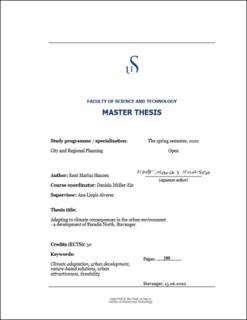| dc.description.abstract | The impacts of climate change are now increasingly relevant in everyday life as projections assert that
many of the future climate consequences are now no longer possible to avert. This has created a recent
realization of the need to adapt to future climate changes as opposed to avoiding their pathway. As urban
projects take several years to develop and are supposed to last decades, urban planners will need to
proactively adapt their projects to climate consequences far into the future. Furthermore, urban areas
are often vulnerable to climatic impacts as a result of their prevalent expanse of impervious surfaces and
increased density of people. It is therefore imperative to integrate climate adaptation into urban
development in an effective, cohesive and attractive manner so that intolerable risks are mitigated and
liveability is increased.
This thesis will therefore explore how an urban area can be developed with an increased focus on building
climate resilience. A masterplan with design principles and guidelines specifically suited to climate
adaptation has been constructed for the undeveloped urban area of Paradis North, Stavanger in Norway.
Projections of climate consequences in the RCP8.5 scenario have been used as the baseline for adaptation
measures, whereas strategies and methods of urban climate adaptation have been acquired through
relevant literature. The development area’s exposure to climate impacts has been studied through a
spatial analysis to create an understanding of the required climate adaptations.
Consequences related to rising sea levels, increasing temperatures, and stormwater flooding have been
addressed primarily through low-impact development and nature-based solutions. Factors relating to
wind- and sun conditions have also been addressed. Nature-based solutions proved an invaluable asset in
the development of the masterplan due to their versatility. Several adaptations, such as urban wetlands,
parks, or trees, were applicable in distinct ways as adaptation measures to a multitude of climate
consequences while also integrating attractiveness and liveability in the urban setting | |
